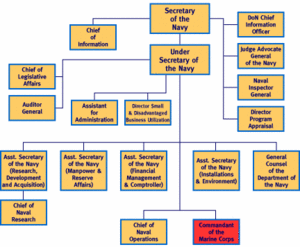Secretary of the Navy (U.S.)
The Secretary of the Navy (SecNav) is the civilian head of the U.S. Department of the Navy, under which are various civilian offices, the Chief of Naval Operations (CNO), and the Commandant of the Marine Corps (CMC). Even though the CNO and CMC report to SecNav, none of the three have control over the operating forces of the United States Navy or United States Marine Corps.
Control over operating forces starts with the President and Secretary of Defense (SecDef), who direct the commanding officers of the [[Unified Combatant Command]s (UCC). The UCCs, which have components from all the military services and have either a geographic (e.g., Pacific, Central) or functional (e.g., Special Operations, Transportation) responsibility. Jointly, the President and SecDef form the National Command Authority.
It is the responsibility of the Secretary, his civilian deputies (who may have uniformed direct reports), and the CNO and CMC to prepare the forces for operational deployment under the UCCs.
The Secretary of the Navy (SECNAV) is responsible for, and has the authority under Title 10 of the United States Code, to conduct all the affairs of the Department of the Navy, including: recruiting, organizing, supplying, equipping, training, mobilizing, and demobilizing. The Secretary also oversees the construction, outfitting, and repair of naval ships, equipment and facilities. SECNAV is responsible for the formulation and implementation of policies and programs that are consistent with the national security policies and objectives established by the President and the Secretary of Defense. The Department of the Navy consists of two uniformed Services: the United States Navy and the United States Marine Corps.
The Secretaries of the Army and Air Force have similar responsibilities to prepare the force. There is no Secretary of the Marine Corps.
